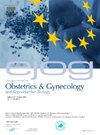Paternal exposure to antidiabetic medications during reproductive period and adverse birth outcomes: A meta-analysis and systematic review
IF 1.9
4区 医学
Q2 OBSTETRICS & GYNECOLOGY
European journal of obstetrics, gynecology, and reproductive biology
Pub Date : 2025-10-02
DOI:10.1016/j.ejogrb.2025.114747
引用次数: 0
Abstract
Background
Diabetes affected approximately 6% of all adults globally in 2021, and the use of antidiabetic medications is expected to increase among men of reproductive age. The impact of paternal exposure to these medications during spermatogenesis on offspring is still unclear.
Objective
To review the association between paternal use of antidiabetic medications during spermatogenesis and adverse birth outcomes.
Data sources: On 27 January 2025, a systematic search of Medline, Embase and Cochrane libraries was conducted without restriction on publication year, supplemented by a manual search.
Study selection and synthesis: Population-based studies examining paternal preconception exposure to antidiabetic medications compared with non-exposed fathers were included. Study quality and validity were assessed using the MOOSE guidelines, and synthesis used fixed- and random-effects models. The Oxford Centre for Evidence-Based Medicine and risk-of-bias tools were also used.
Main outcome: Congenital malformations.
Results
Of 2859 studies identified, four met the inclusion criteria. Two studies (2,435,462 births analysed) linked metformin to congenital malformations [adjusted odds ratio (aOR) 1.40, 95 % confidence interval (CI) 1.08–1.82; p = 0.012; adjusted hazard ratio 1.4, 95 % CI 1.11–1.76]. The common-effect model for metformin and congenital malformations was non-significant (aOR 1.05, 95 % CI 0.95–1.17) with high heterogeneity (I2 = 76.9 %) (p = 0.0017).
Conclusion and relevance.
Paternal use of metformin during spermatogenesis was not consistently associated with congenital malformations based on low-certainty evidence. Further studies should investigate polytherapy and poorly controlled diabetes as risk factors for adverse birth outcomes.
父亲在生育期间服用抗糖尿病药物与不良分娩结局:荟萃分析和系统回顾
2021年,糖尿病影响了全球约6%的成年人,预计育龄男性中抗糖尿病药物的使用将增加。在精子发生过程中,父亲接触这些药物对后代的影响尚不清楚。目的探讨精子发生过程中父亲使用降糖药与不良分娩结局的关系。数据来源:2025年1月27日,对Medline、Embase和Cochrane图书馆进行了系统检索,不受出版年份限制,并辅以人工检索。研究选择和综合:纳入了以人群为基础的研究,检查父亲孕前接受抗糖尿病药物治疗与未接受抗糖尿病药物治疗的父亲的比较。采用MOOSE指南评估研究质量和有效性,综合采用固定效应和随机效应模型。牛津循证医学中心和偏倚风险工具也被使用。主要结局:先天性畸形。结果在2859项研究中,有4项符合纳入标准。两项研究(分析了2,435,462例新生儿)将二甲双胍与先天性畸形联系起来[调整优势比(aOR) 1.40, 95%可信区间(CI) 1.08-1.82;p = 0.012;校正风险比1.4,95% CI 1.11-1.76]。二甲双胍与先天性畸形的共同效应模型无统计学意义(aOR 1.05, 95% CI 0.95-1.17),异质性高(I2 = 76.9%) (p = 0.0017)。结论和相关性。基于低确定性证据,精子发生期间父亲使用二甲双胍与先天性畸形并不一致相关。进一步的研究应该调查多种治疗和控制不良的糖尿病作为不良出生结局的危险因素。
本文章由计算机程序翻译,如有差异,请以英文原文为准。
求助全文
约1分钟内获得全文
求助全文
来源期刊
CiteScore
4.60
自引率
3.80%
发文量
898
审稿时长
8.3 weeks
期刊介绍:
The European Journal of Obstetrics & Gynecology and Reproductive Biology is the leading general clinical journal covering the continent. It publishes peer reviewed original research articles, as well as a wide range of news, book reviews, biographical, historical and educational articles and a lively correspondence section. Fields covered include obstetrics, prenatal diagnosis, maternal-fetal medicine, perinatology, general gynecology, gynecologic oncology, uro-gynecology, reproductive medicine, infertility, reproductive endocrinology, sexual medicine and reproductive ethics. The European Journal of Obstetrics & Gynecology and Reproductive Biology provides a forum for scientific and clinical professional communication in obstetrics and gynecology throughout Europe and the world.

 求助内容:
求助内容: 应助结果提醒方式:
应助结果提醒方式:


